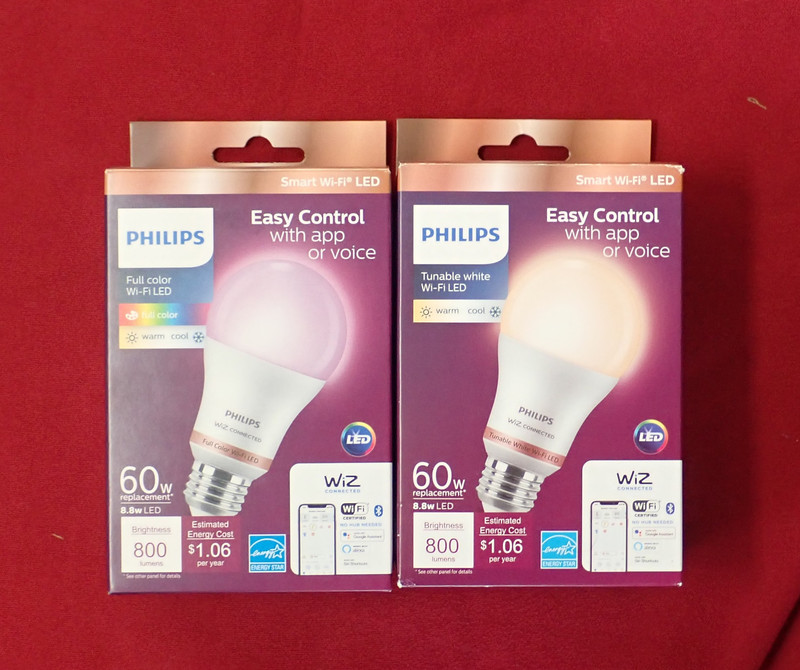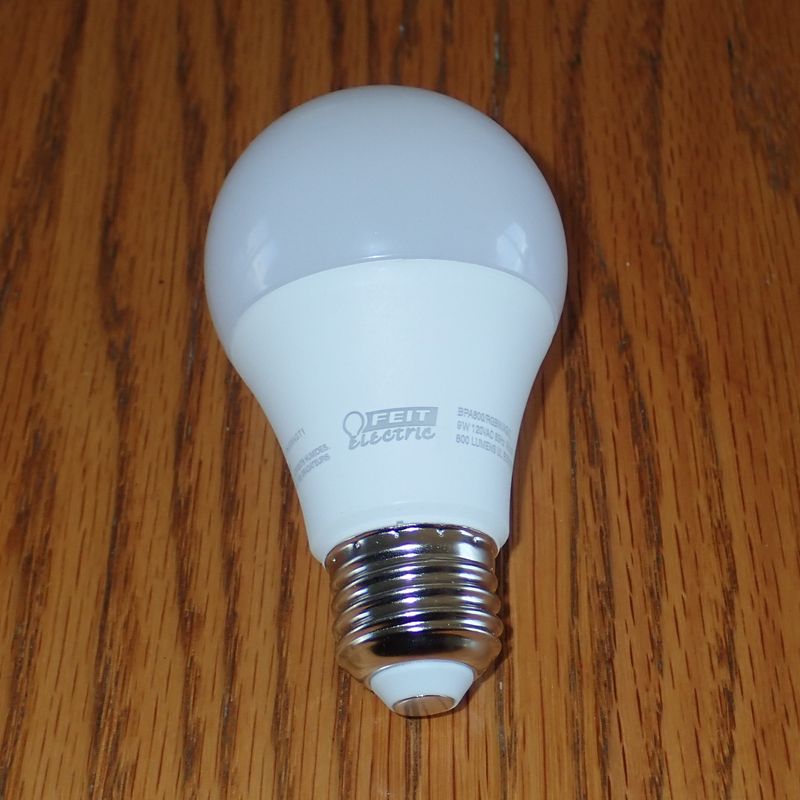This week, I’ve attached two more lightbulbs to my network, because… apparently this is what you do with lights now. I’ve hooked up a pair of Philips WiFi bulbs, and run their output into my spectrometer to see how they behave and what’s going on with their emissions.
I grabbed two different bulbs - one that’s simply a color temperature shifting white bulb, and one with the full RGB emitters (in addition to the color shifting white emitter) and proceeded to poke/prod/analyze them.
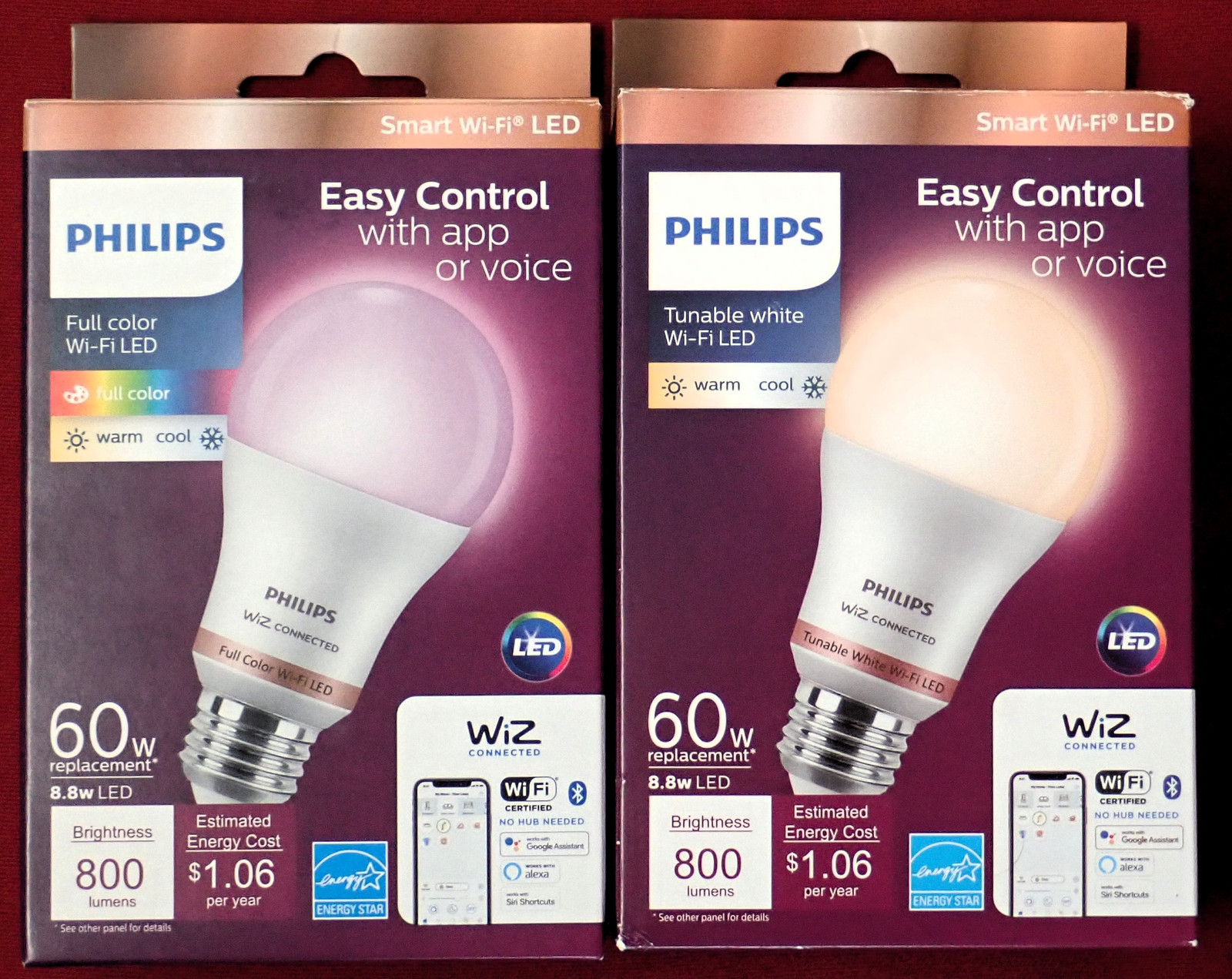
The Philips WiFi WiZ Bulbs
I’m not quite sure what Philips is doing with bulbs, because they sure seem eager to sunset old bulbs (the Hue series comes to mind, as does the Warm Glow stuff I’ve used). But these are, as of early 2023, what they sell as “smart bulbs.” They’re 2.4GHz only WiFi bulbs, have the required App(TM), and do things. On the left, a full RGBW bulb with color temperature shifting, and on the right, just the color temperature shifting version. They look like almost all the other LED bulbs.
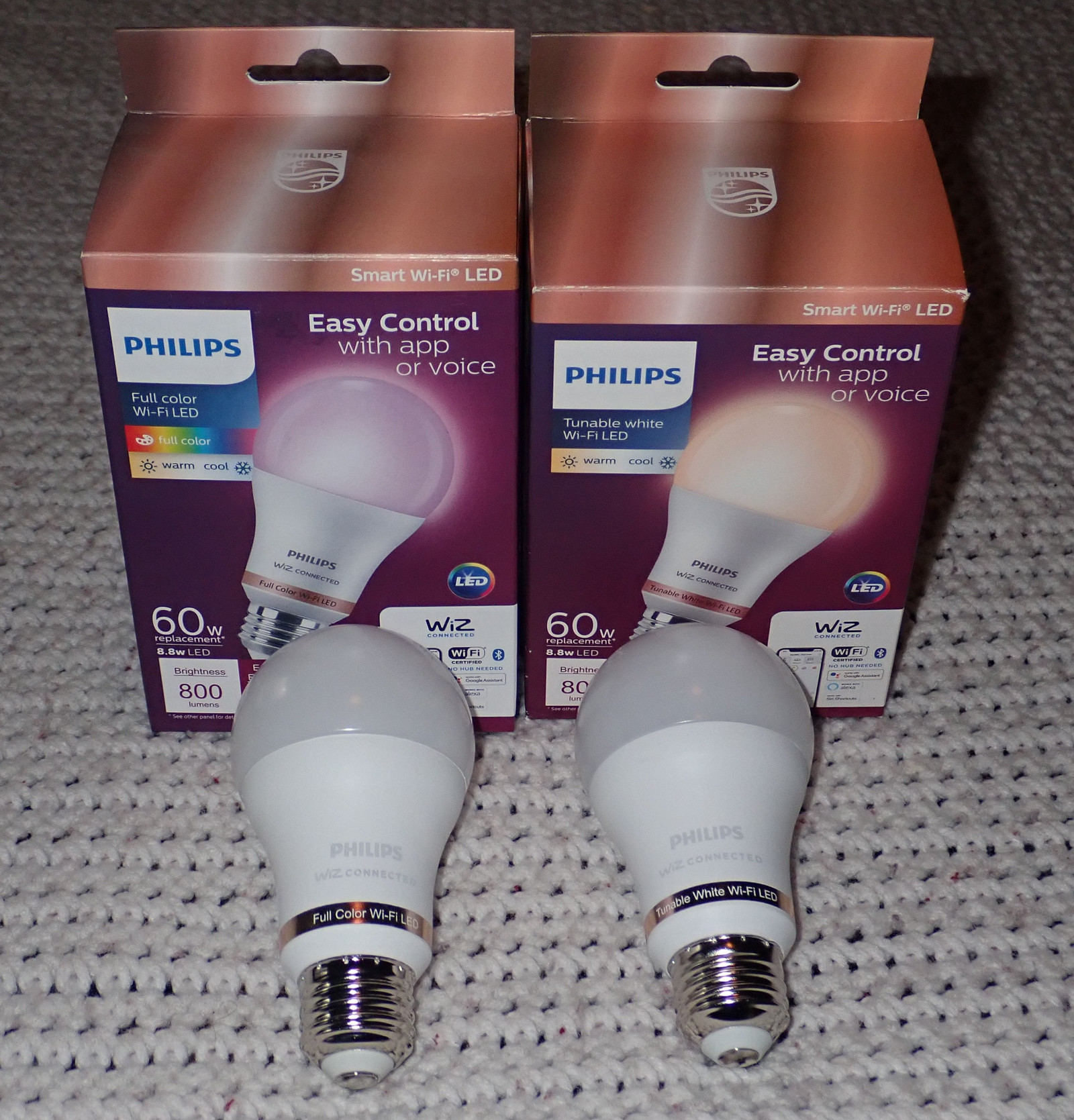
They’re rated 800 lumens at 8.8W, which… sure, I don’t have the equipment to test either one exactly, but it’s probably close enough. I’ve got my questions about how 100mA at 120V works out to 8.8W (seems like 12W to me), but there may be some rounding regulations on amp ratings to avoid claiming something pulls 74mA. It’s also worth pointing out that an older style 60W incandescent will put out about 860 lumens - so comparing lumenous efficiency, it’s a factor of ~6.35x improvement. One can reasonably expect around there - 1/6th the energy per lumen for a LED bulb vs an incandescent, but if someone starts going on about how LEDs use orders of magnitude less energy, call them on it. One can safely assume 1/5th the power and be largely right, some are better, but I’ve yet to see a production bulb using 1/10th the energy of an incandescent.
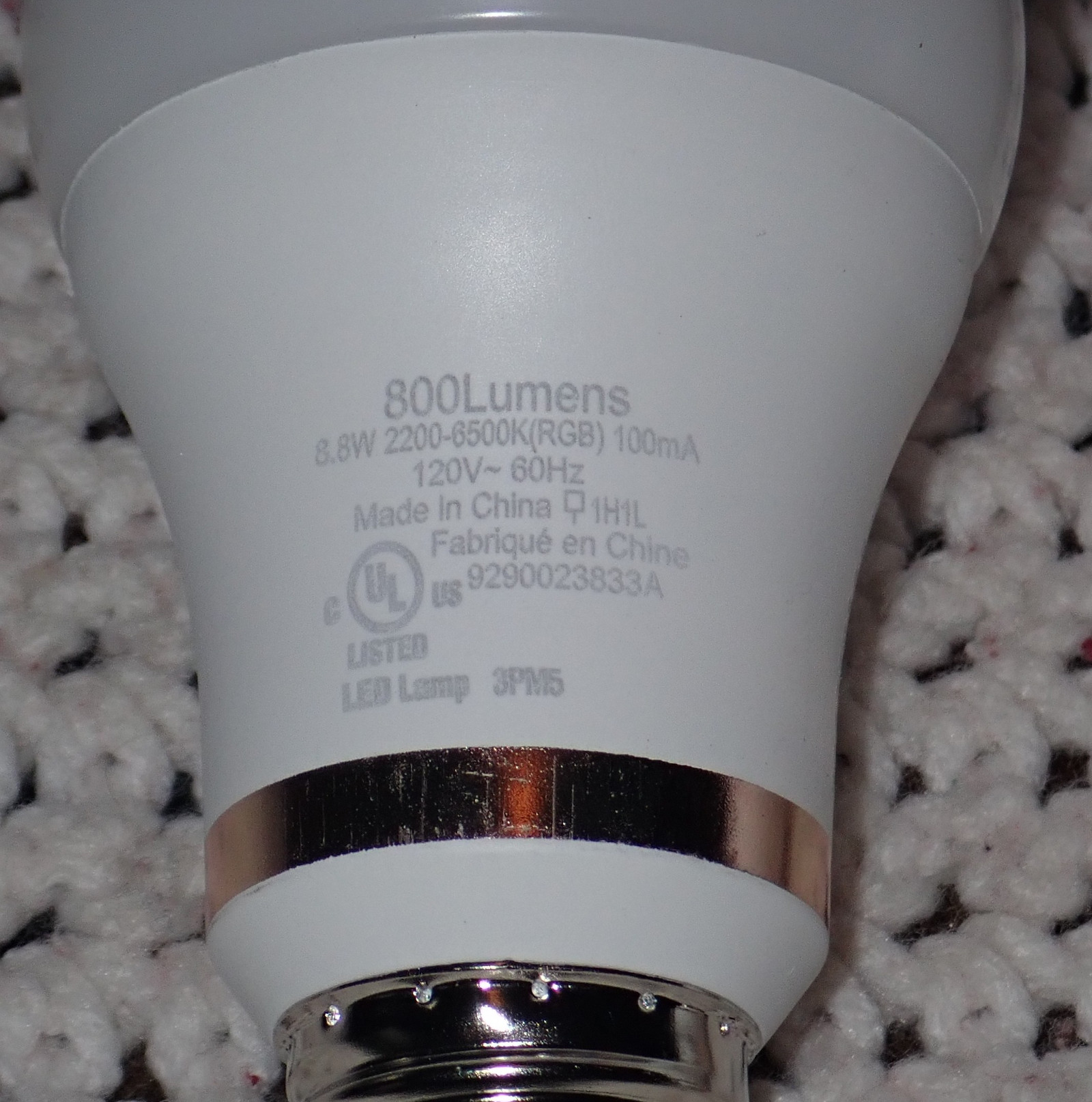
The other side includes some standard enough LED warnings that you might consider pondering. “Do not use with dimmers!” is normal enough (though I’ll explain what that actually means later), but “Not for use in totally enclosed or recessed luminaires!” is related to why a lot of people observe LEDs failing early in actual practice - most homes don’t have bare bulbs, they have recessed or enclosed fixtures. A lot of LEDs aren’t rated for these fixtures - and will overheat in operation. Unlike an incandescent, the power electronics in the LED bulbs really do care about running temperature, and a lot of them are “rather poor” at getting rid of heat. Crank your electronics up a couple dozen degrees above design temperature, your service life will end up being very poor - as many people are learning. Some LEDs are rated for enclosed fixtures, and you should probably buy those.
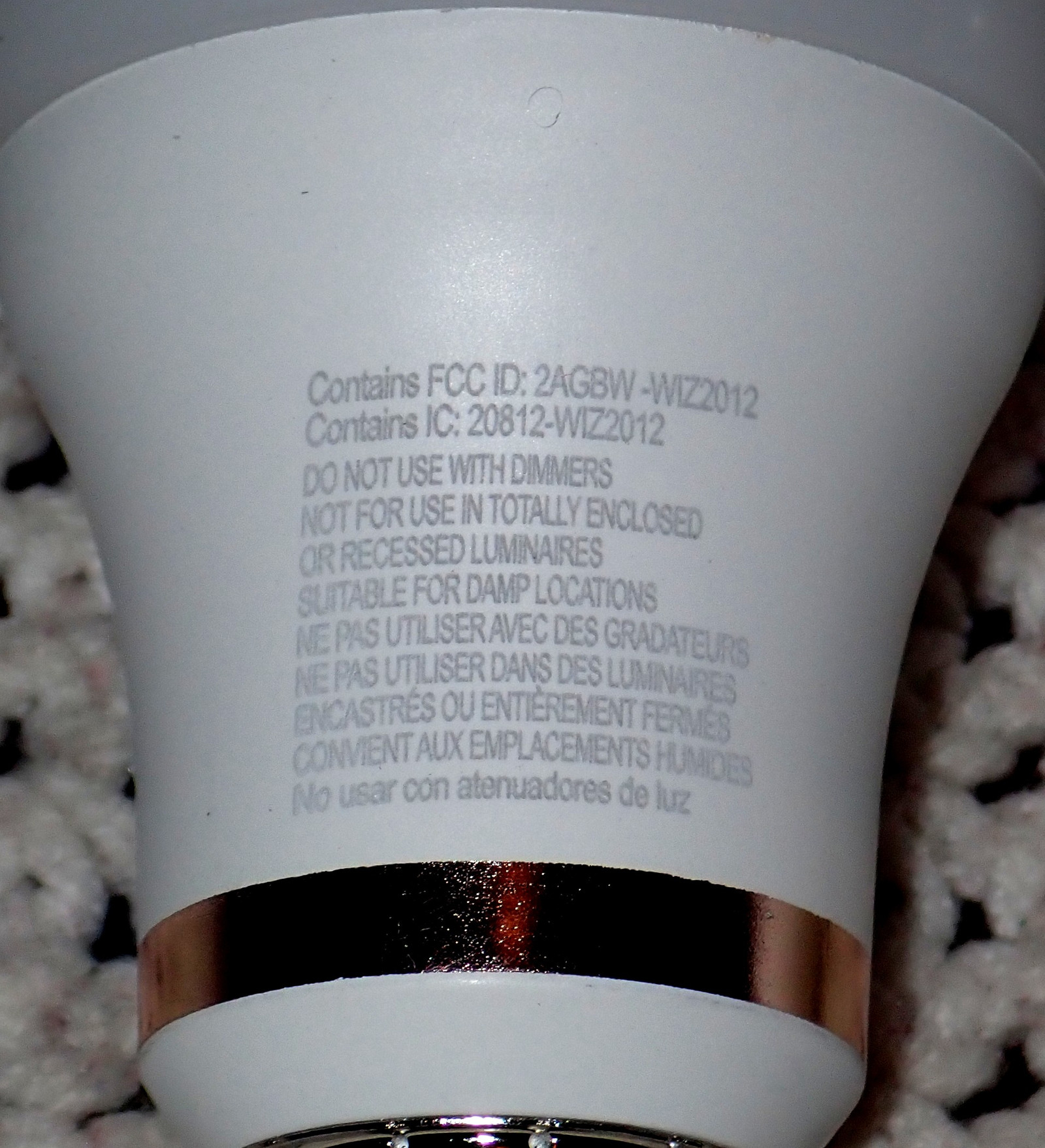
The boxes will usually tell you as well. If it says this, don’t buy it. K?

Why Do I Care?
This may, at first glance, seem a weird set of posts for me. Why do I suddenly care about smart light bulbs, or LED color spectrums? The long form answer to this can be found in a previous post of mine, How Your LED Lights and Screens are Killing You. Our modern white LEDs emit quite a bit of blue, squarely in the regions of spectrum that the human eye uses to determine if it’s daytime (about 440-490nm). At their core, they’re a blue LED with a phosphor coating, and some of that blue leaks past. Some lights emit more, some emit less, and since I now have a spectrometer, I’ve been pointing it at a range of bulbs to better understand how much blue they leak in various modes.
If you’re struggling with sleep at night, my advice is to be very careful of the blue light after dark. I’ve gone back to incandescent light sources on dimmers in areas I use at night, with some very real improvements in how quickly I go to sleep and how well I sleep. At a minimum, you should ensure all your LEDs are “as warm as possible” in light after sundown, but even from there, they tend to still leak a lot of blue compared to an incandescent light source.
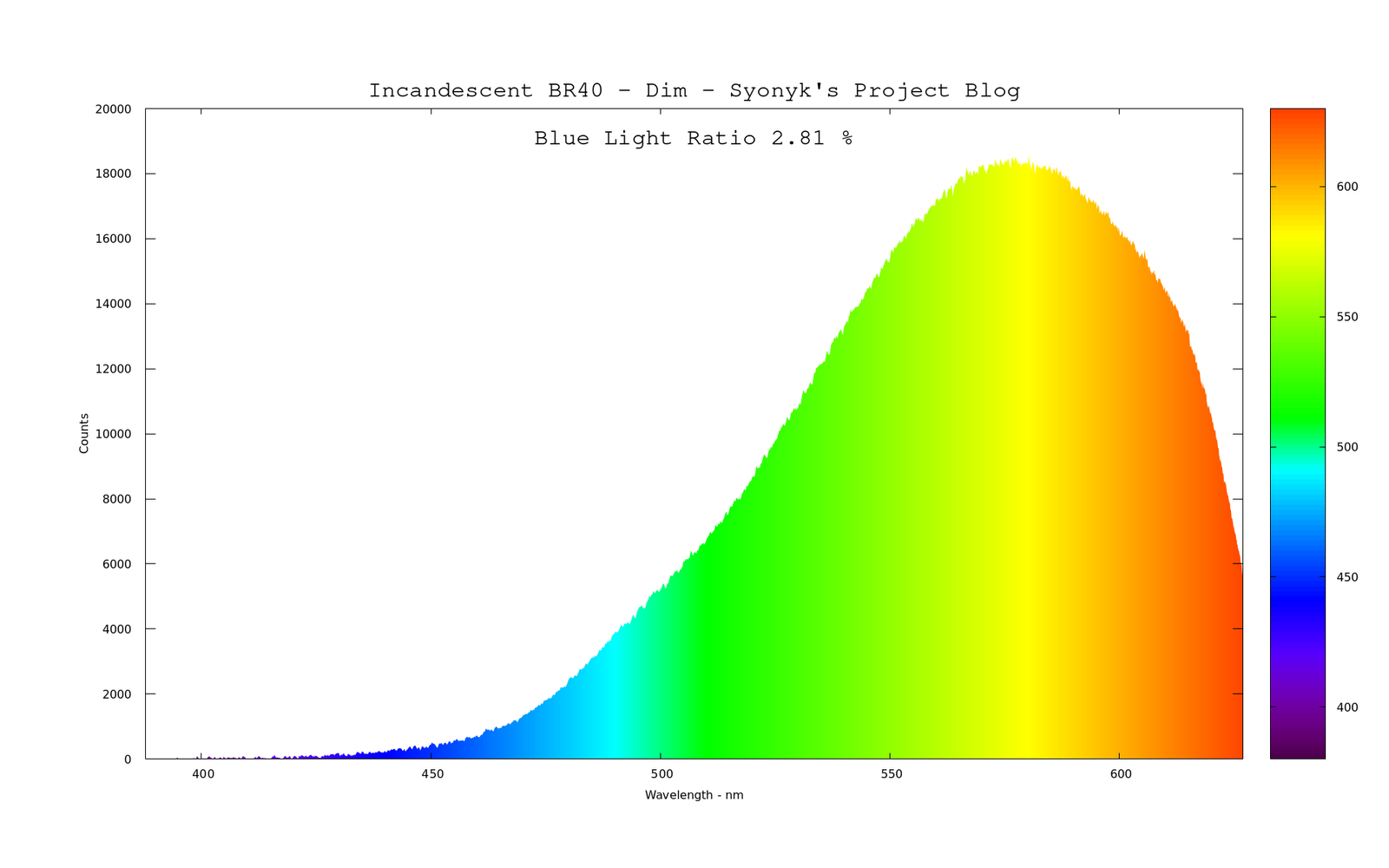
The White Color Shifting Bulb
I’m starting here with the white bulb, which has two controls: Dimming and color temperature. This bulb is capable of ranging from 2700K to 6500K, and it dims, though not particularly well as far as I’m concerned. I like a dimmer to be able to run a bulb all the way down to zero, and there’s no good reason a bulb that’s always powered can’t do it - but this one doesn’t, just like any others. You can control the light color shift and dimming in the app, and it works fine.
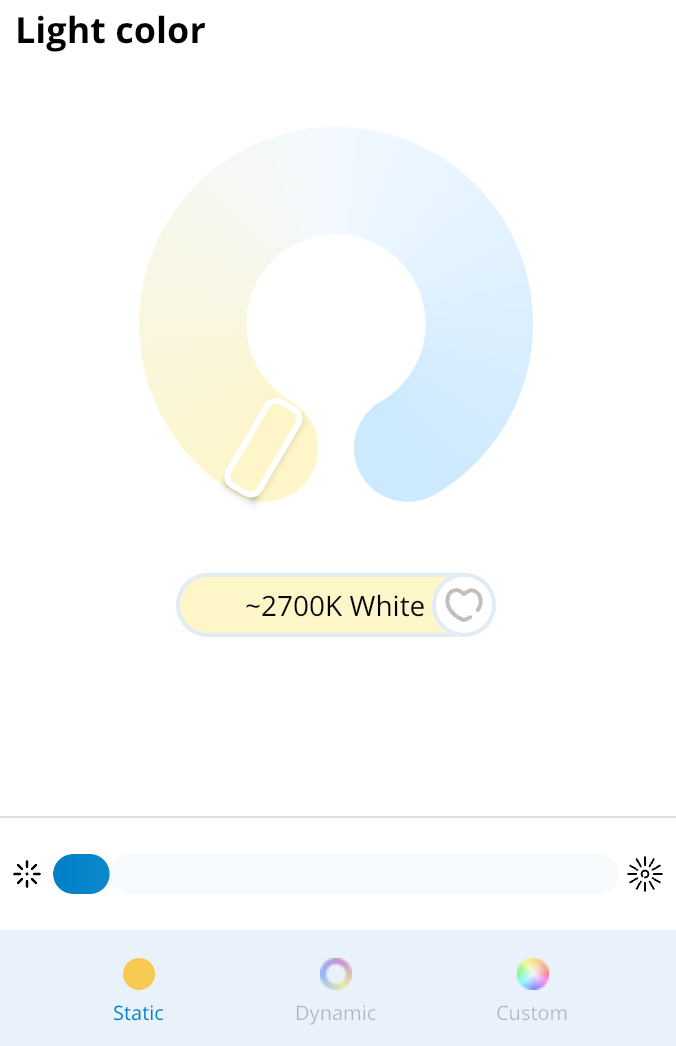
Starting with the 2700K setting, it looks like an LED. Blue bulge starting in the 450nm range, with the bulk of the emissions coming off the phosphor coating that’s being driven by the LEDs. The major surprise here are those spikes over in the reds, up past 600nm. There are three spikes over there, on top of the normal curve. It looks a bit like my iPhone 2020 SE’s behavior in the reds, but it’s certainly not something you pick up with your eyes. Both of the Philips bulbs do this when their white emitter is running.
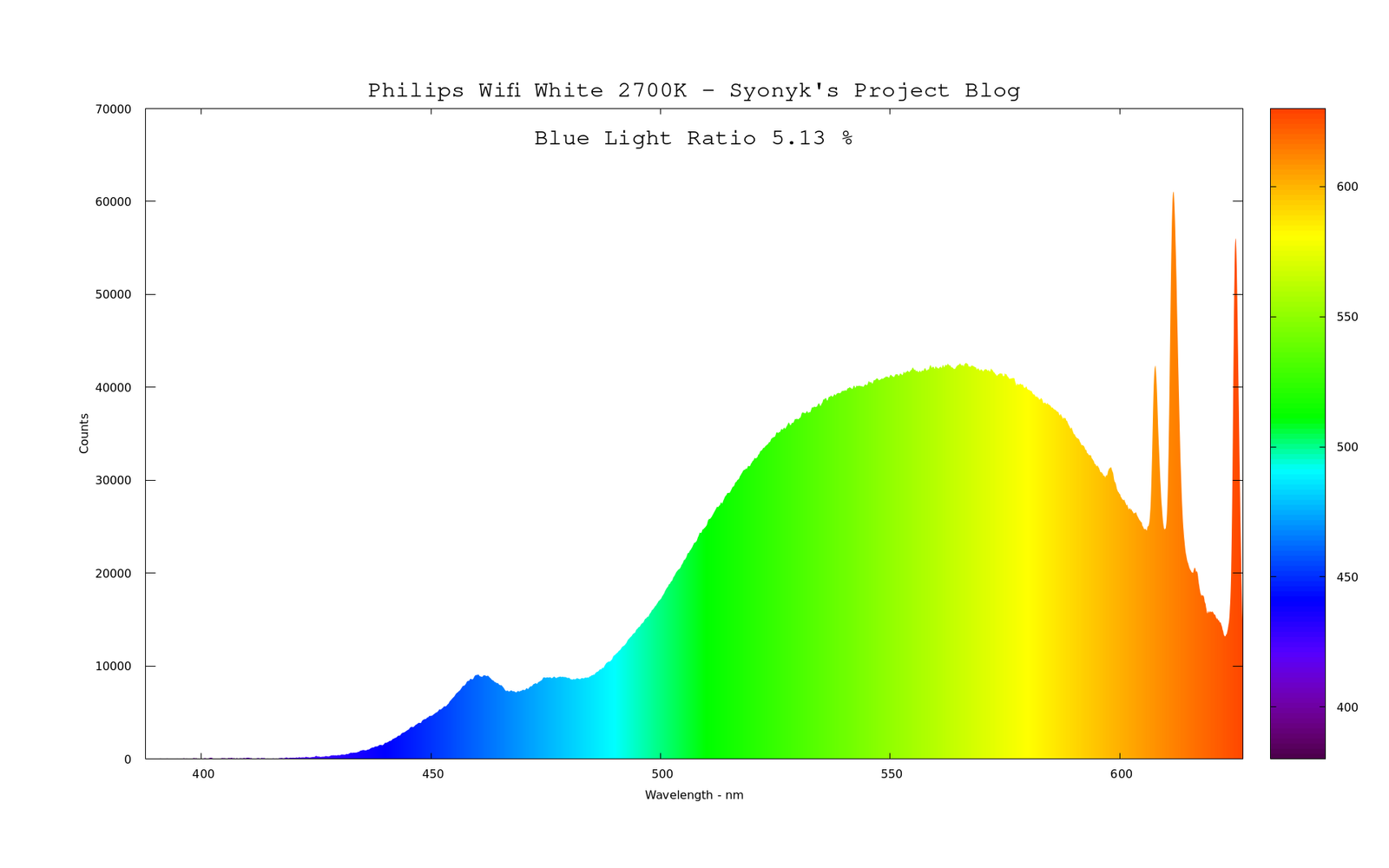
As the color temperature goes up, there’s obviously going to be more blue - but the biggest surprise to me was just how much of a difference going from 2700K to 3000K made. Just that tiny 300K tweak in color temperature added a ton more blue squarely in the regions that matter.
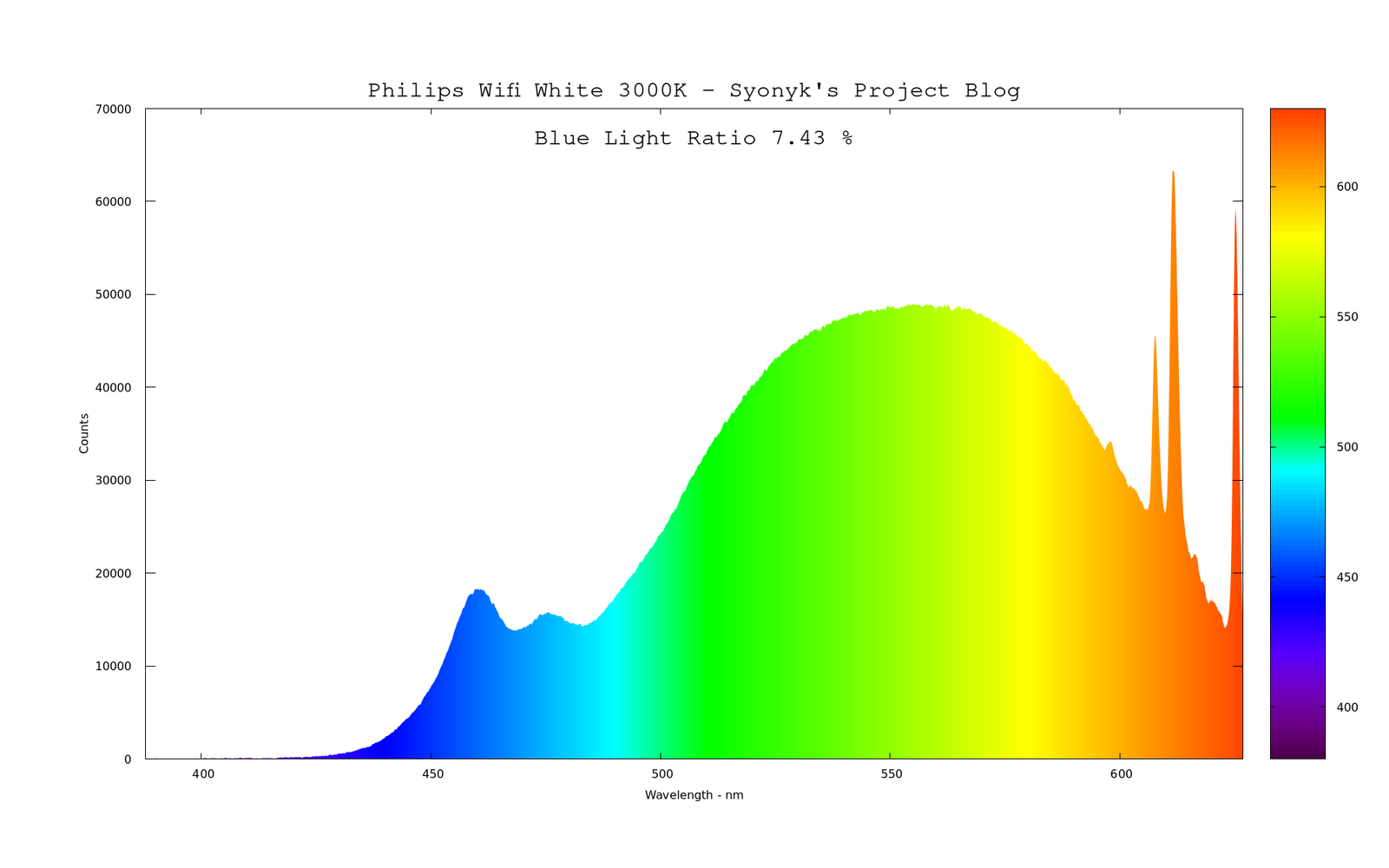
There’s no surprise - as the color temperature gets warmer, the amount of blue just keeps increasing. This 5000K setting is the typical “daylight” setting for a bulb.
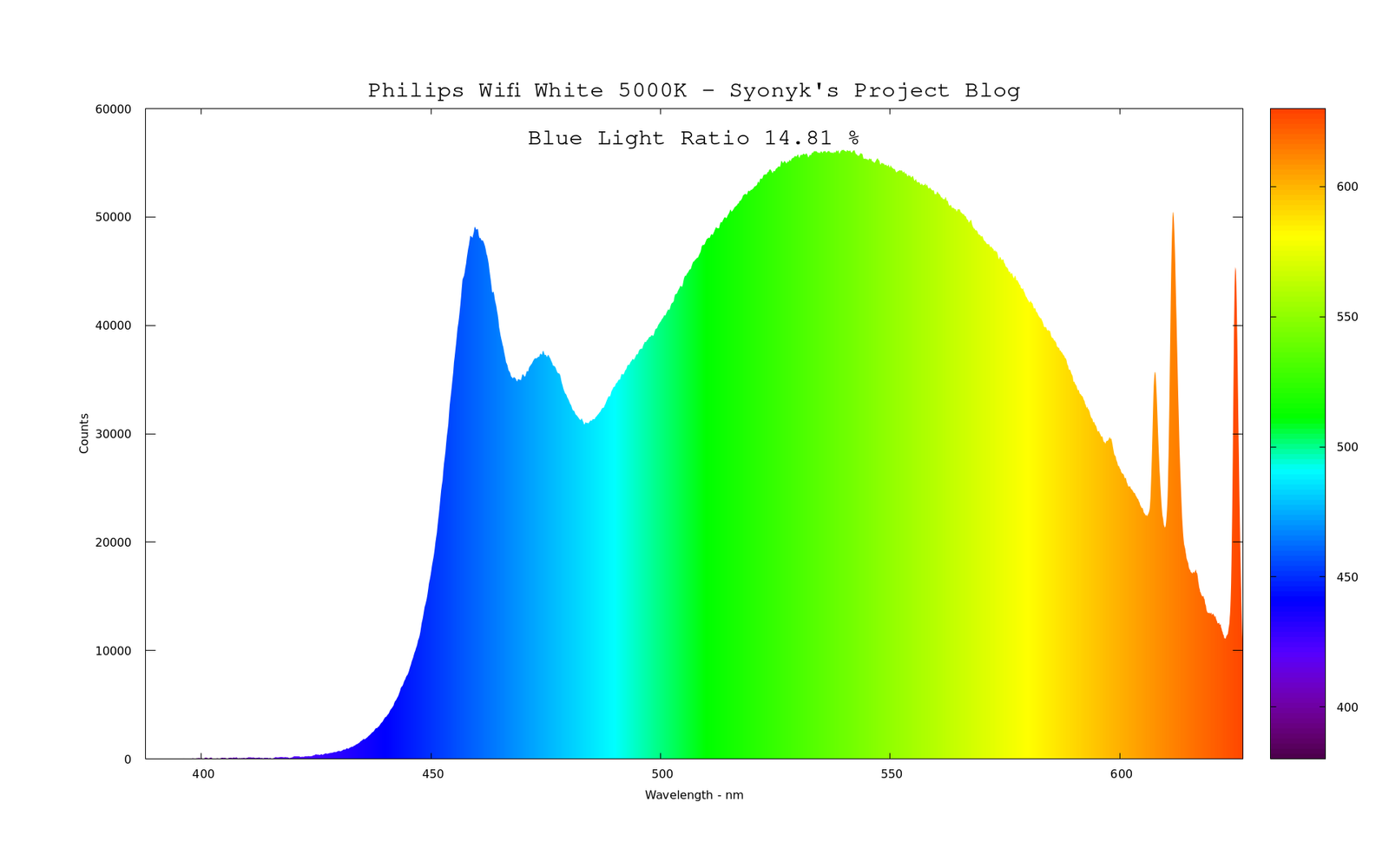
And finally, up at the maximum color temperature, 6500K is what you’d expect to see. Lots more blue, lots less “everything else.” Even the red spikes have started to drop very noticeably compared to the blue and greens up here. This is a great mode to help wake you up in the morning, and an absolutely awful mode to be using at night. There’s no real harm in blue during the day, and if anything, we need more blue light during the day to compensate for the lack of sun most of us get. But you absolutely don’t want to be using settings anywhere near this at night, because they will keep you awake through suppressing melatonin production, with all the nasty consequences of that.
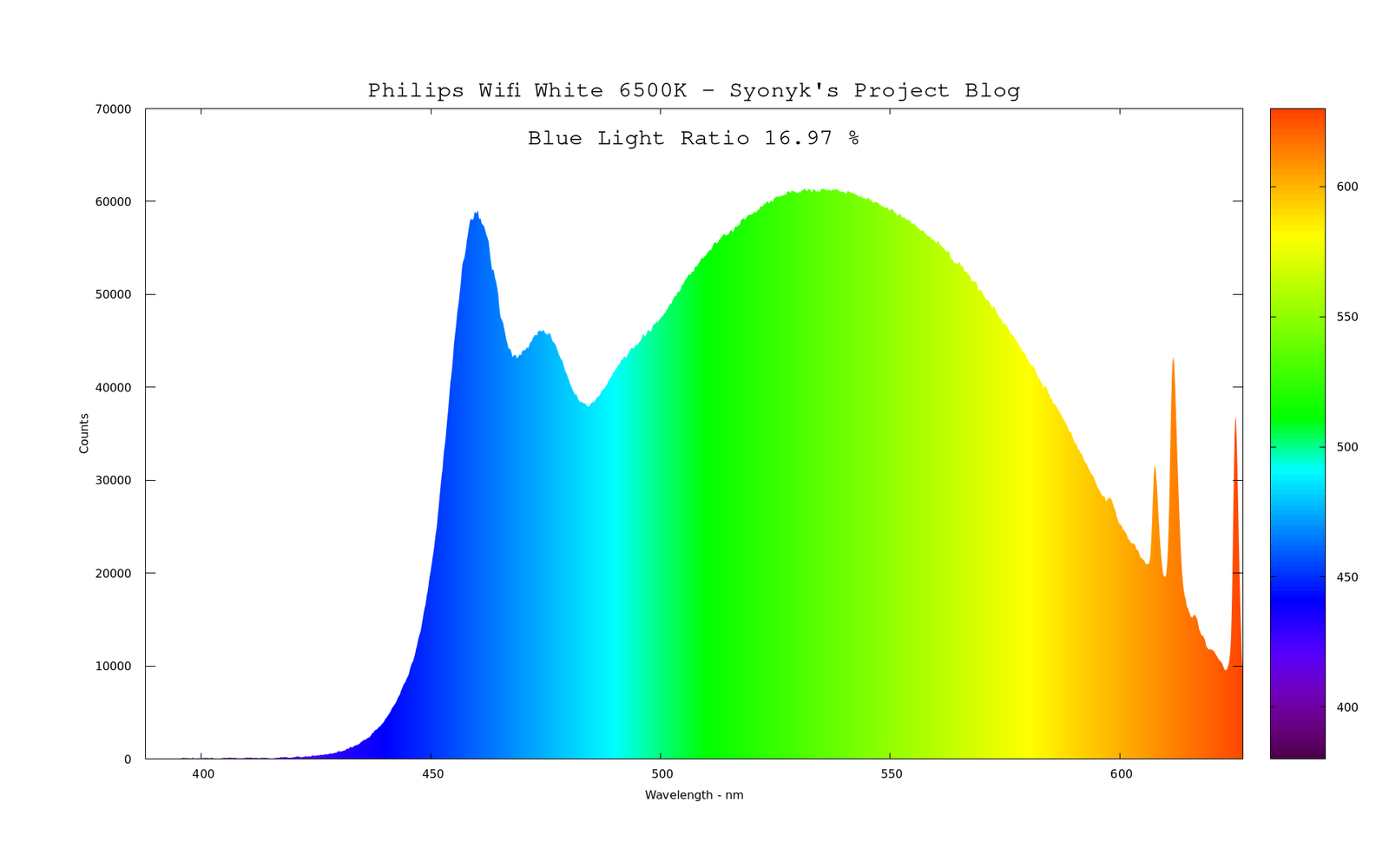
Overall, the “color temperature changing” white bulb does what one would expect it to do. It’s probably fine during the day, but even in the 2700K setting, there’s a lot of blue leaking at night - so, at a minimum, keep it dimmed.
The RGBW Bulb
Far more interesting is the behavior of the RGBW bulb. In addition the white emitter, this bulb can do the whole “Show any color you want” trick that’s popular in smart lights. Plus, it claims an increased color temperature range - it can be adjusted from 2200K to 6500K (vs only down to 2700K on the other bulb).
The app allows you to set colors either as hex values, or with a color wheel. Towards the center of the wheel, colors are mostly white, with some tinges of other colors, but as you get out to the edge the saturation increases. Usefully, this app will show you the hex value (RGB) it’s trying to emit.
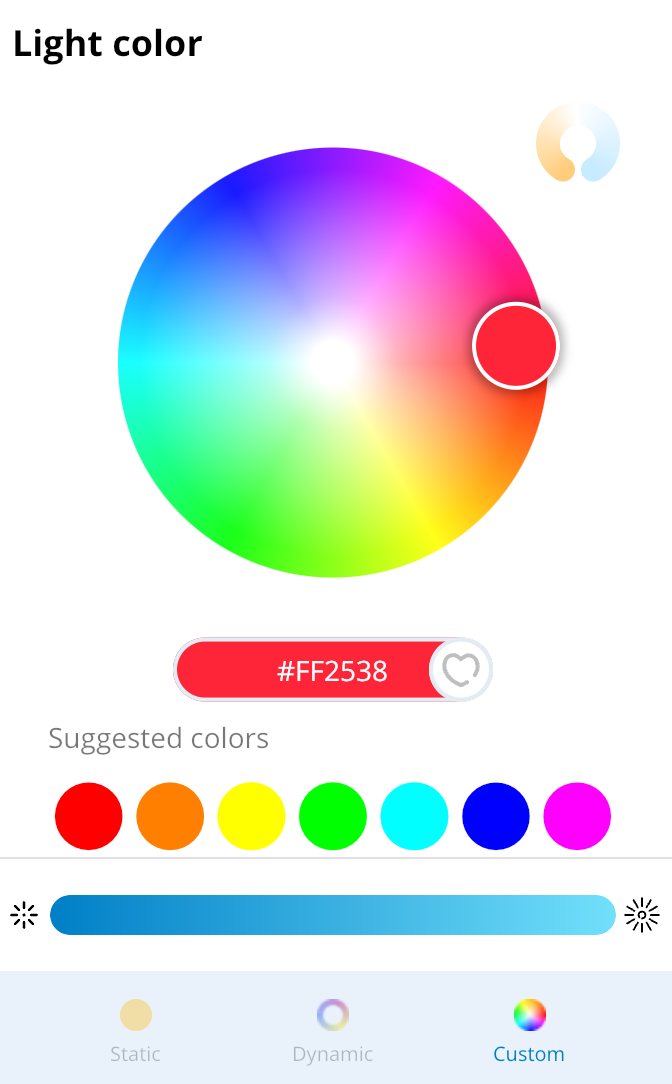
There are a lot of other things the app can do, and I simply don’t care. You can find a review of the app somewhere else. I use it to drive the bulb into the states I want to measure, and that’s it.
Starting out, I set the bulb to 2700K in the “white bulb” mode, expecting to see the same thing I saw with the previous bulb, and in fact, they appear to have the same emitter. As expected, so far. The red spikes, the blue bulge squarely in the human blue light sensitivity region…
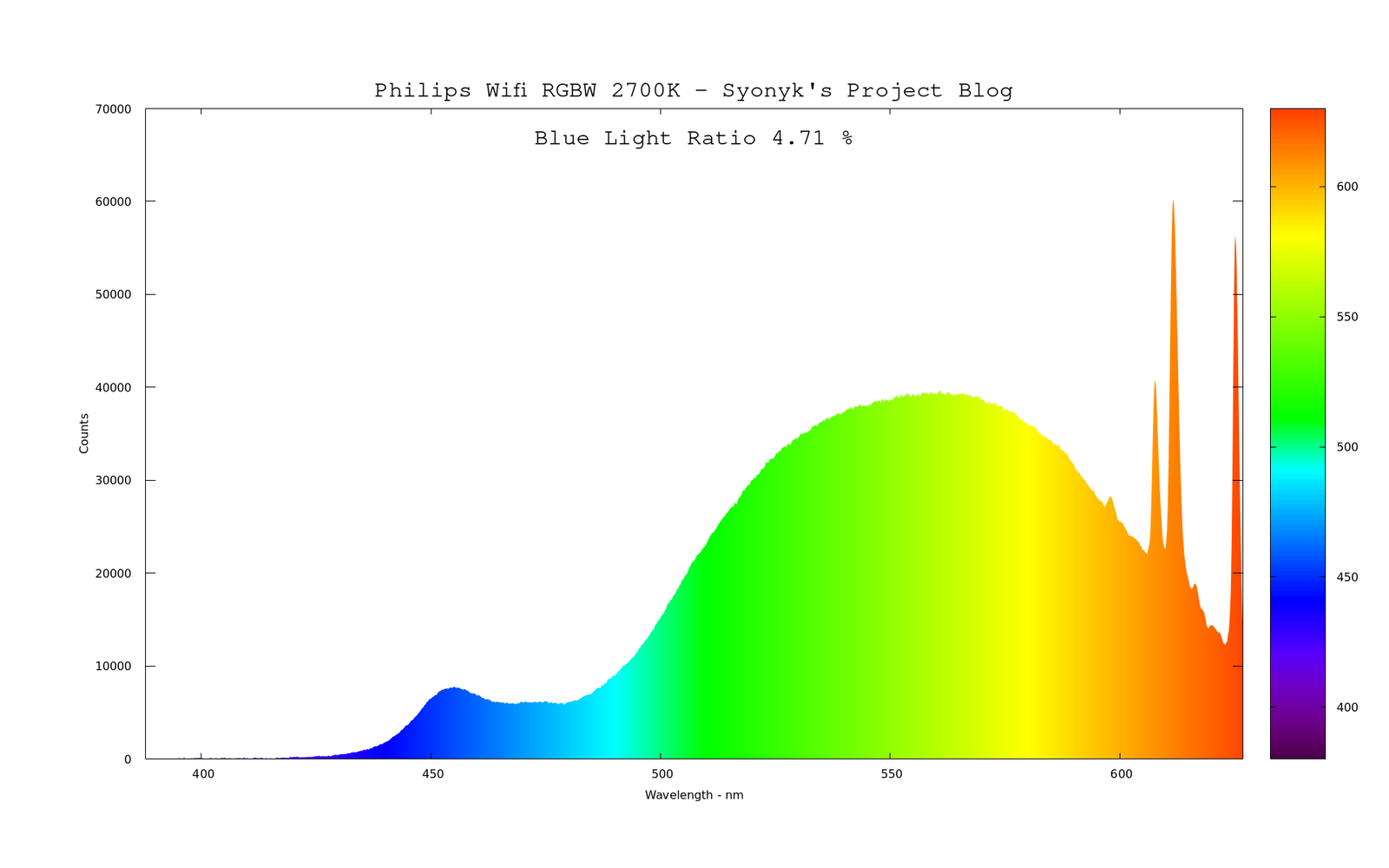
What happens when you set the bulb down to 2200K? It looks a lot redder… but as the spectrum shows, nothing has changed except that it’s added a ton of red. The blue emitter, the phosphor curve, they’re all exactly the same as at 2700K, but the red LED comes on to add more red. Color temperature is nothing but an average of the spectrum as it appears to the human eye, and it can’t tell you anything about the actual distribution of energy throughout the spectrum. You might think that setting the bulb down to 2200K would reduce the blue, but it’s done nothing of the sort. It just adds more red energy. Again, visually, this works, but if you’re looking at the actual blue that screws with sleep, it’s changed nothing. You might be able to dim the bulb a hair and reduce the blue, but fundamentally, it’s just adding some red LED into the existing mix.
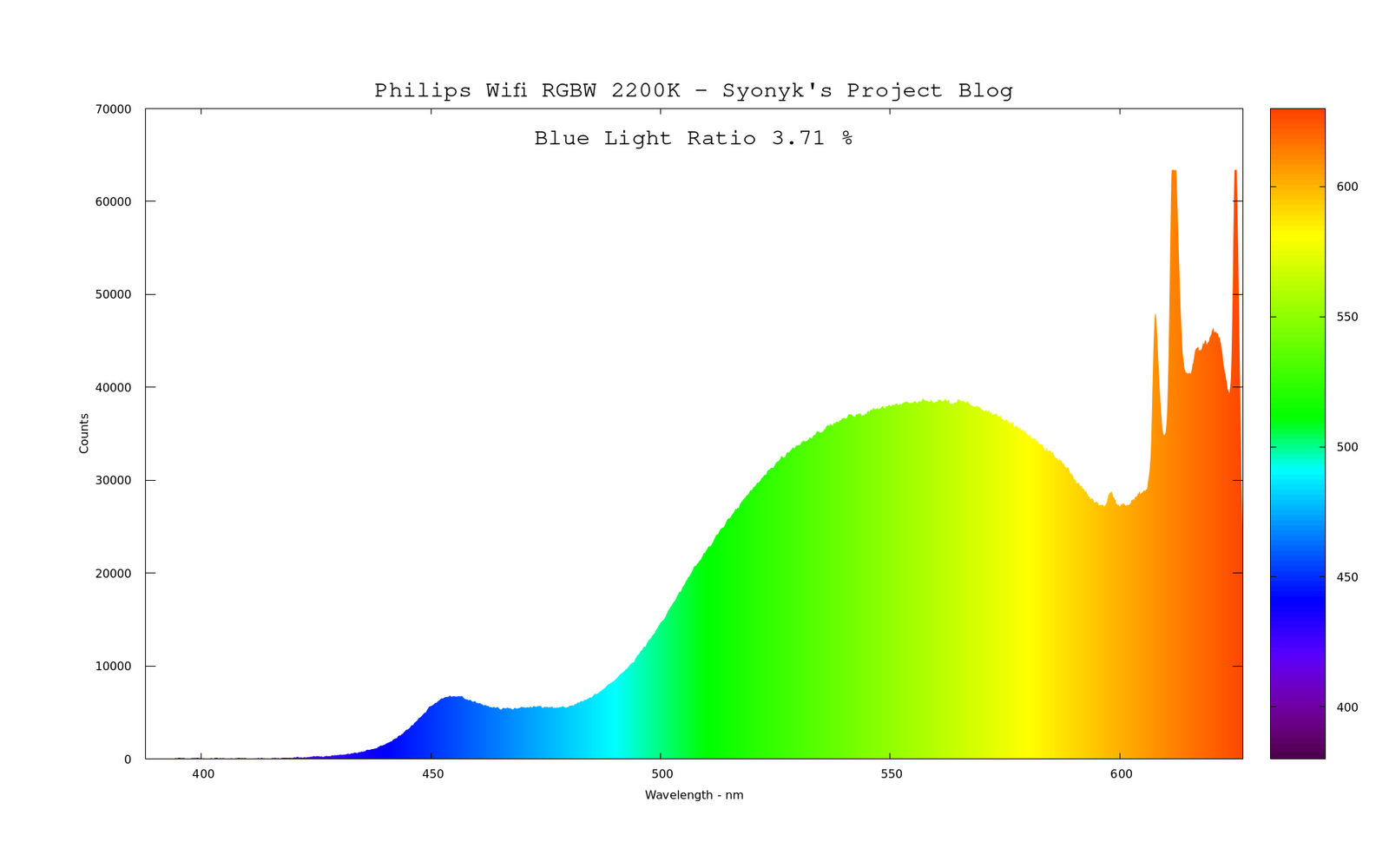
Up at the upper end, nothing else changes either. It appears to be the exact same white LED emitters in both bulbs - the curves are almost identical. This shouldn’t be a surprise, they’re the same company, and the same general category of bulb. Nothing too interesting there.
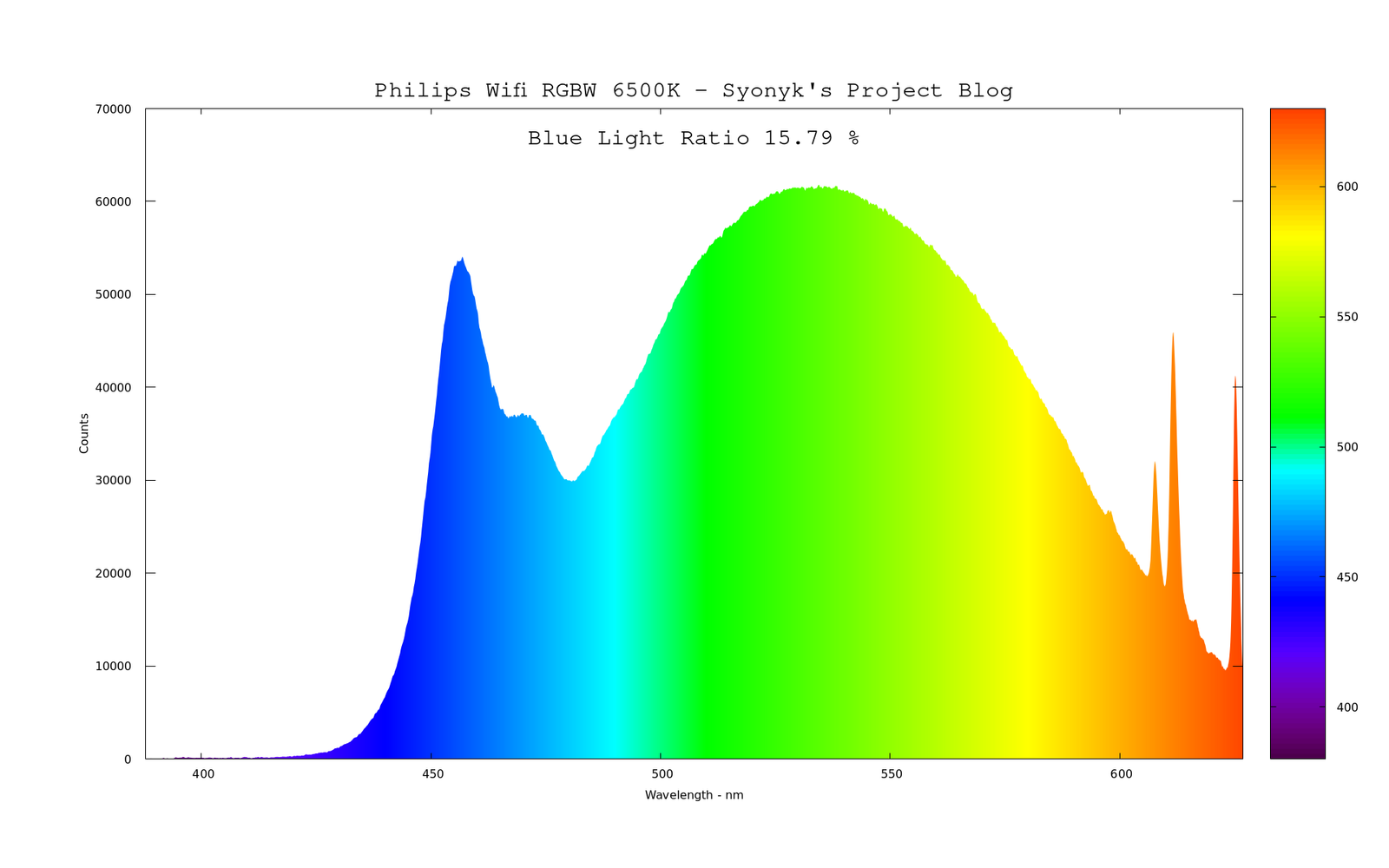
Moving onto the RGB modes, the first major surprise is that in the “white” center of the spectrum wheel, this bulb is using the white emitter. The Feit I reviewed would either run the white emitter or the RGB emitters, but not both. The philips blends in the white emitter as needed to produce the desired light color. Here, it’s more or less centered in the color wheel, and looks a lot like the 2700K spectrum - which, visually, is about where things are.
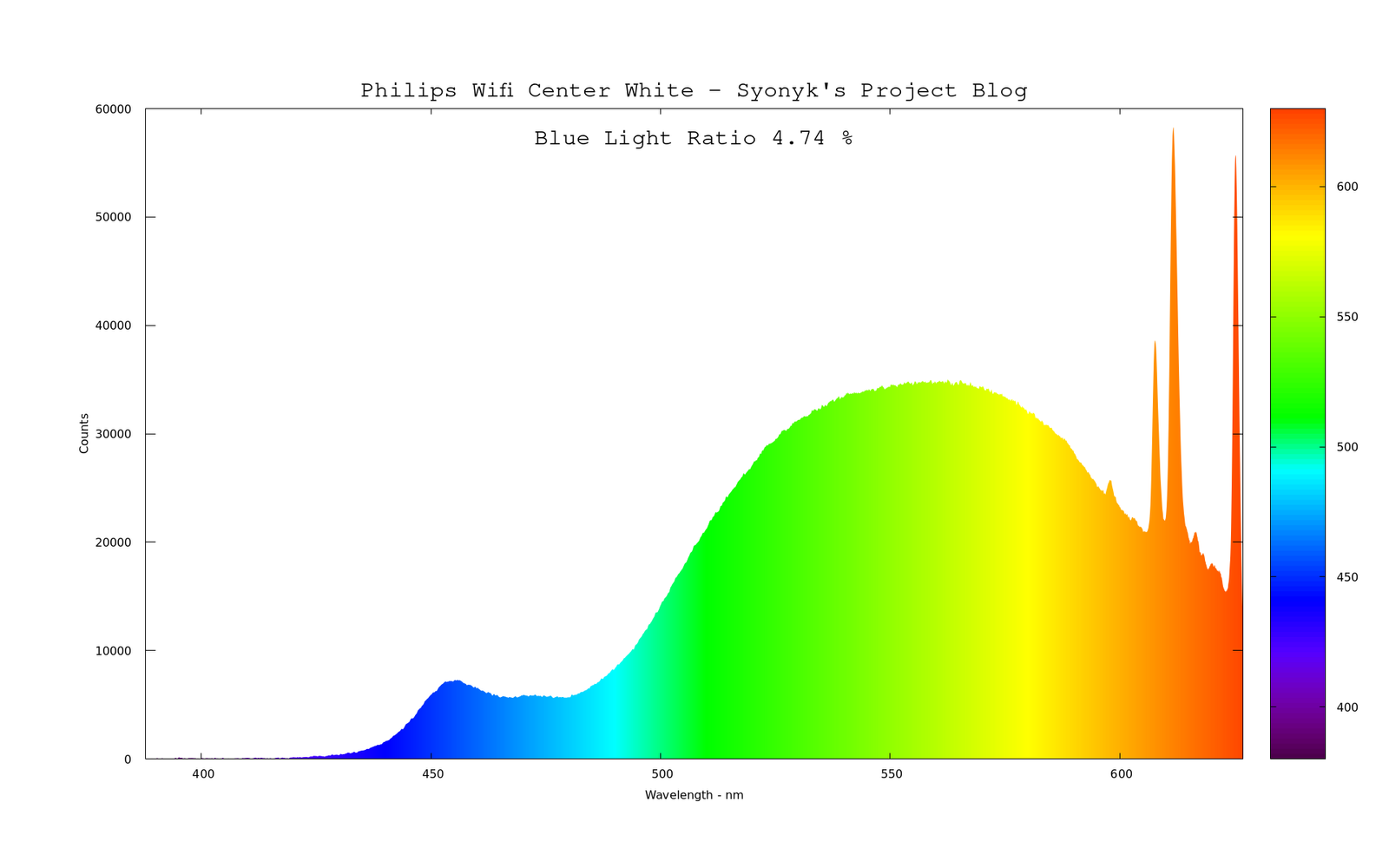
Where this gets interesting is that as you shift the colors around (in this case, out towards the orange), the bulb starts by simply starting to color shift the white spectrum - this is a pale orange, and you can see the rise in the reds, while the rest of the spectrum is still clearly the white emitter purring away at the center.
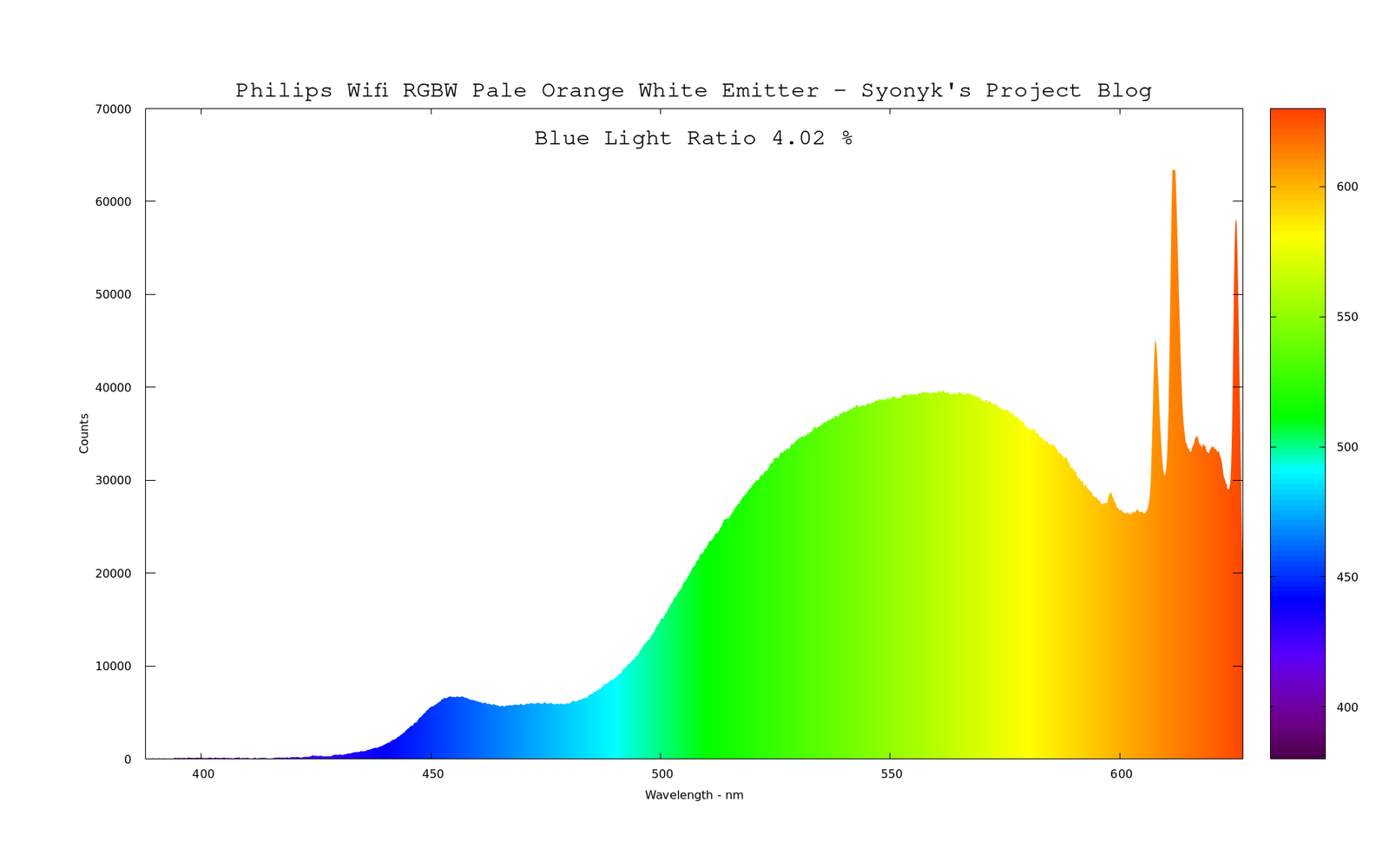
As you move further out, towards a more saturated orange, all of a sudden the light shifts modes. There isn’t any clear visual indication that it’s done this, but now, despite the light still being a pale orange, the white emitter has dropped off and it’s now in pure RGB mode (you see the three spikes, and the blue peak has shifted up noticeably). Look at the spike in blue compared to the above - despite being a more saturated orange, there’s a radical increase in the blue coming out of the bulb. In this case, the whiter light actually has a lot less blue in it.
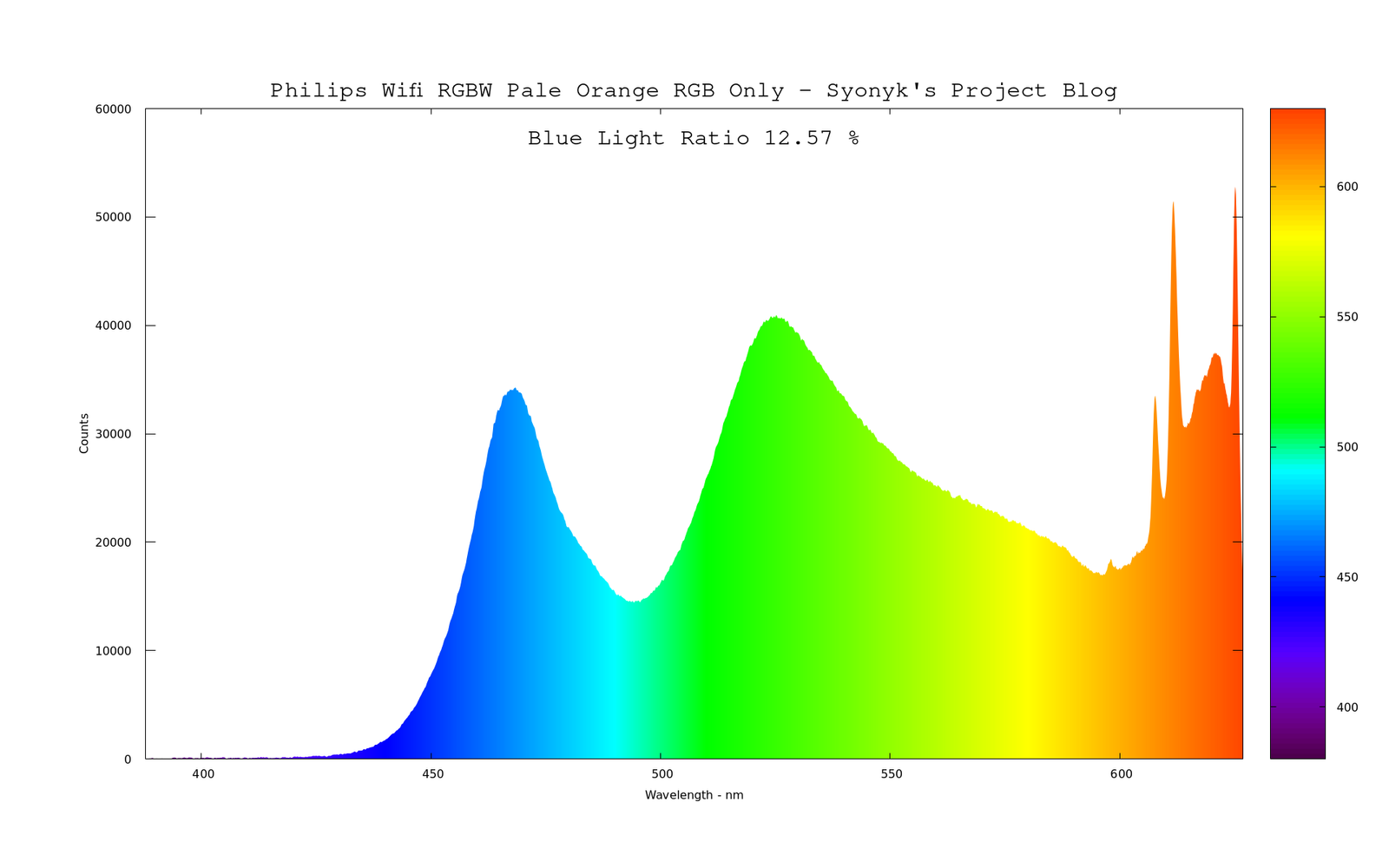
Keep going out, and eventually you hit a fully saturated point, in which there’s no blue left - but the transition from the white emitter to the RGB emitters really spiked the blue hard. There’s no guarantee about what it’s putting out, without actually having a spectrometer to see what the bulb is doing.
Though I will say that when the RGB value has “00” in the blue field (the last two digits), it seems that the bulb really is blue-free. It doesn’t mean you can make nice colors out of it without blue, but it also seems to very much obey the hex values in terms of the light intensity in each of the colors.
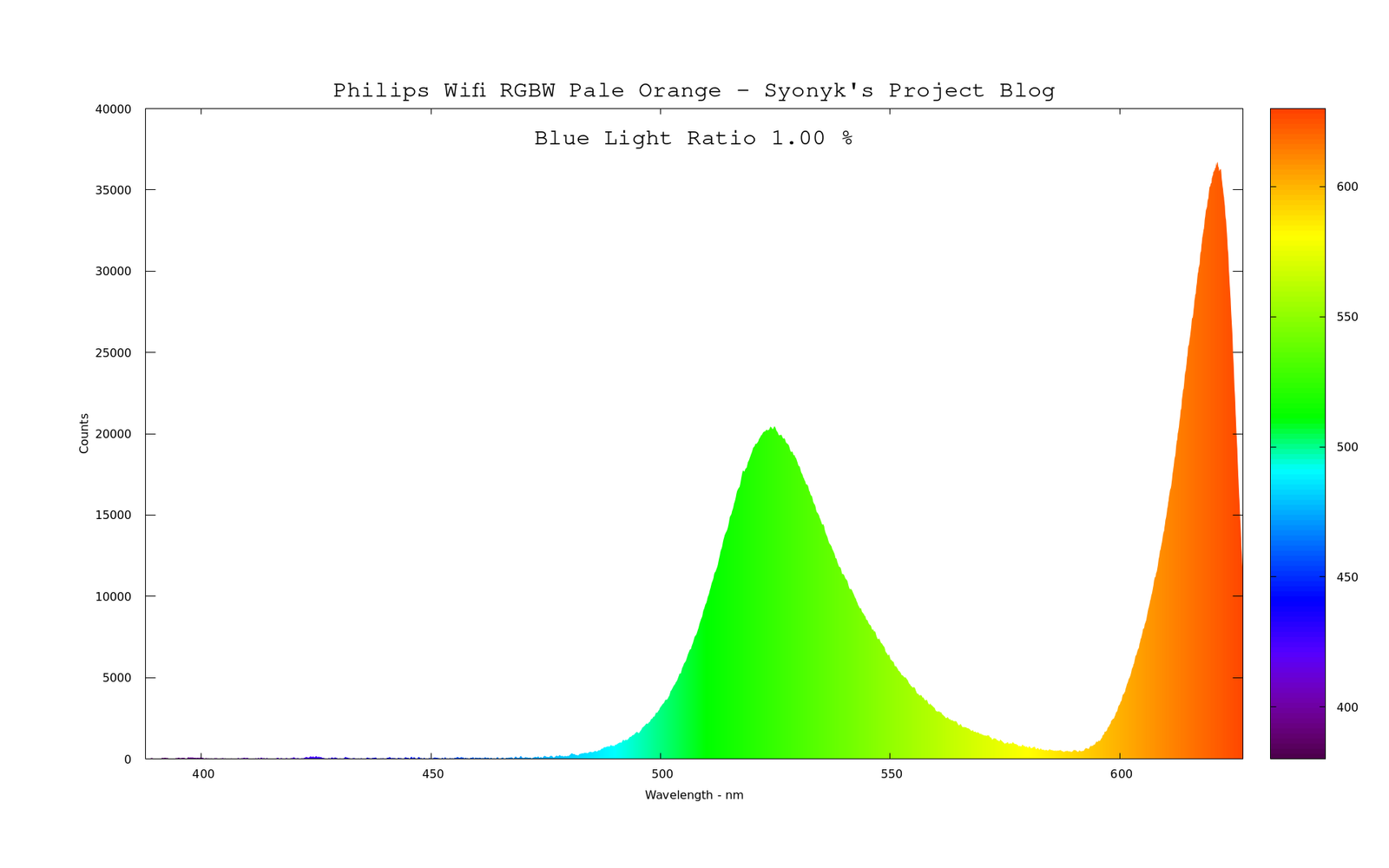
Looking at each of the colors separately, blue seems to peak somewhere right around 468nm. Squarely in the middle of the “bioactive blue regions that suppress melatonin,” and, in fact, this is almost a perfect overlap with some of the observed sensitivity curves. Great to wake you up during the day, not so good in the evenings.
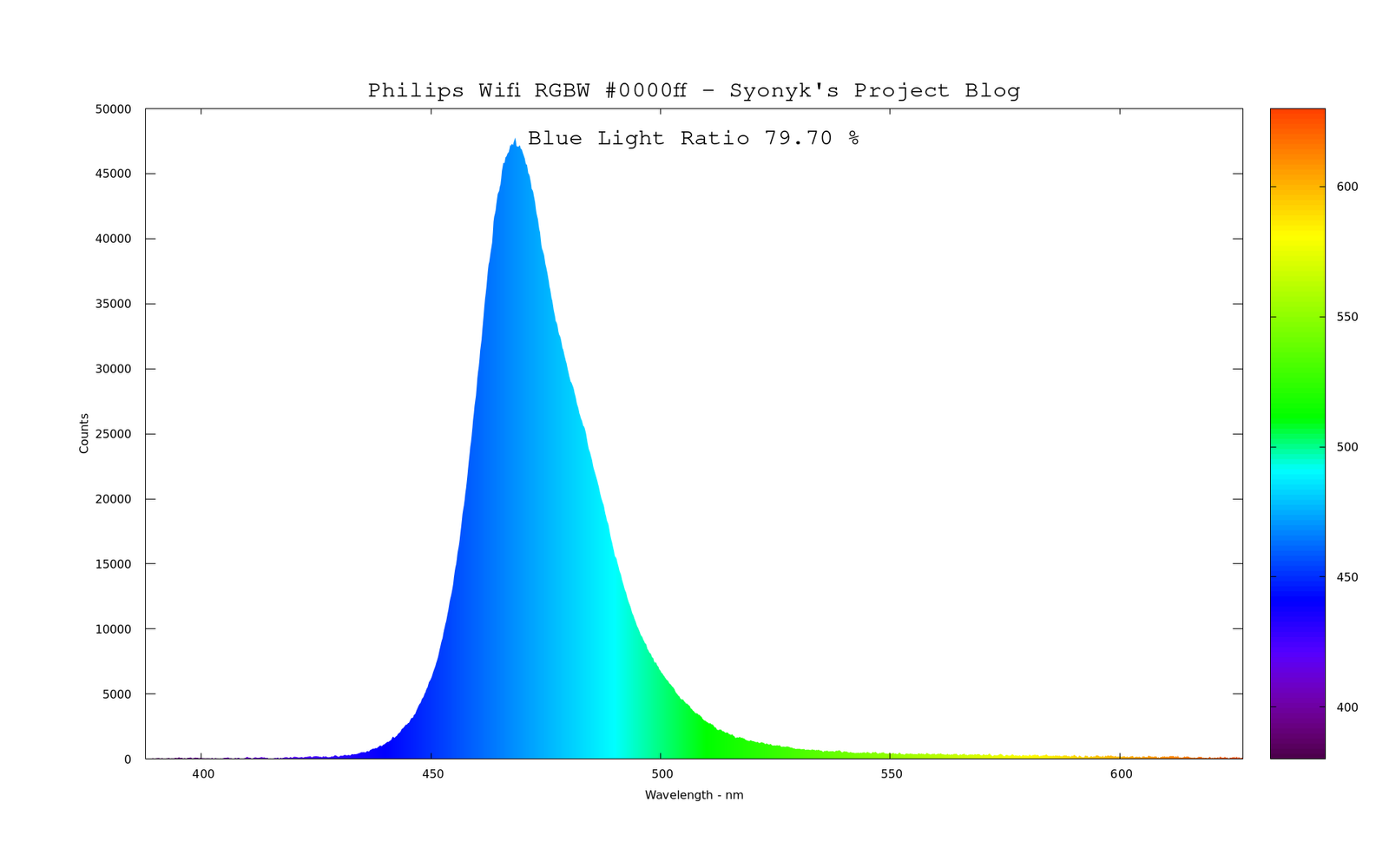
Green peaks right about 524nm - not a bad place for green to be.
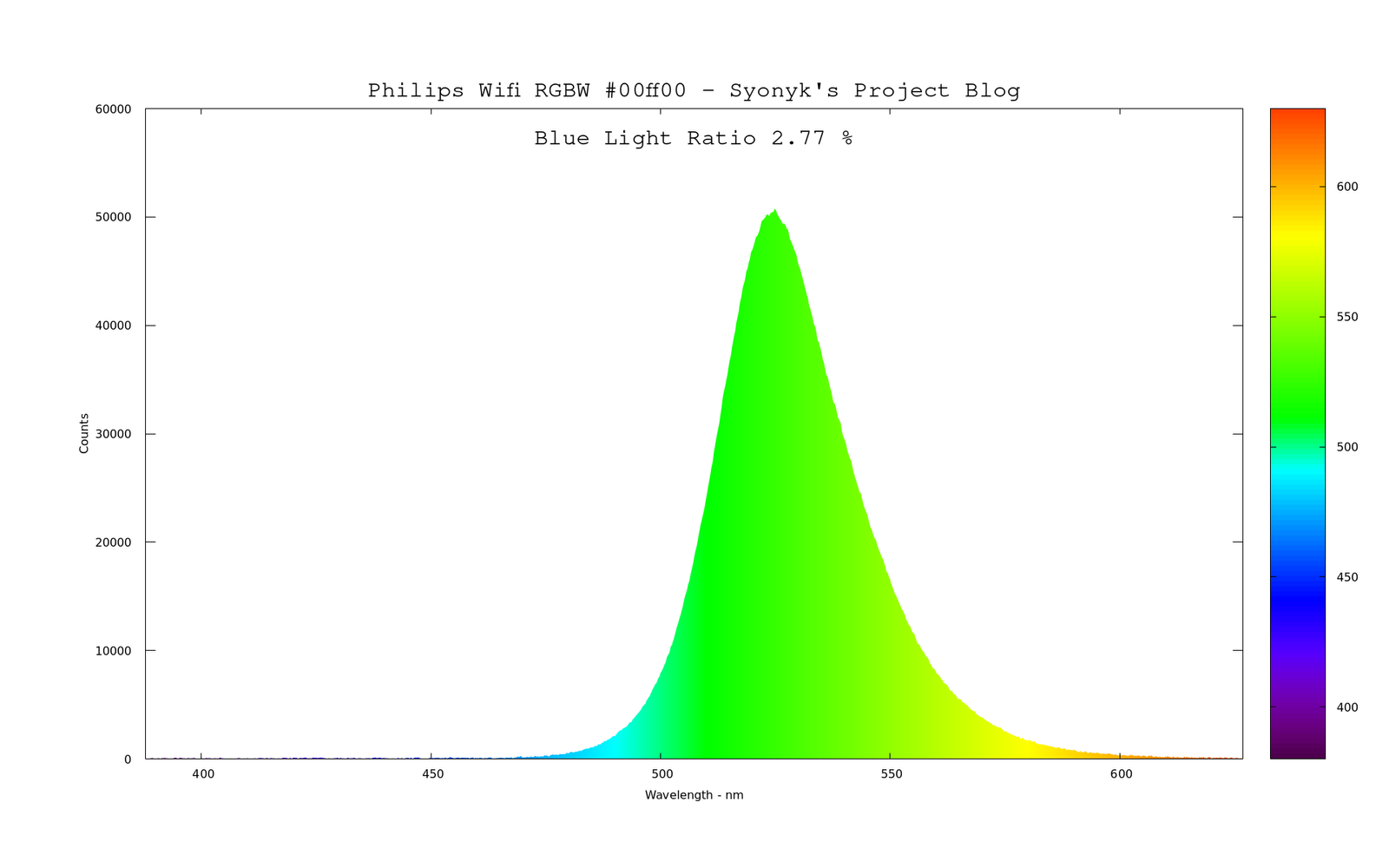
And red seems to peak, at least given my meter’s sensitivity (which is dropping off by the reds), right around 621nm. If you want to play Hunt for Red October, the red off this light will work perfectly well for that!
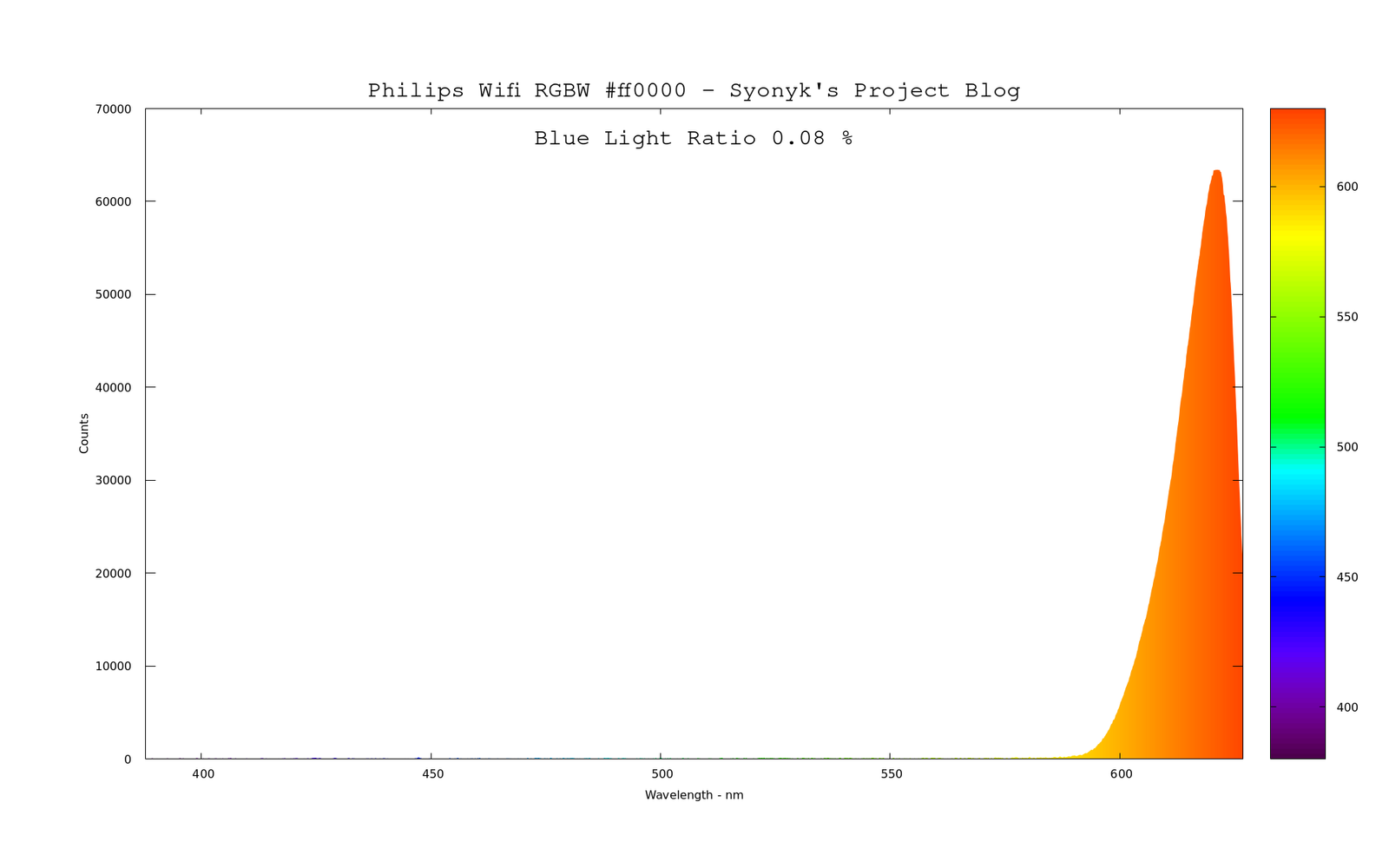
But, you can see in these graphs very clearly that the bulb obeys the hex values - it does, once you’re out in the saturated rim, do what you told it to do. And that’s nice to see!
Do Not Dim?
Do not dim? Why not? I attached these bulbs to my little dimmer adapter, and proceeded to dim them.
The “color shifting white” bulb actually obeys dimming reasonably. As you dim it down, it gets dimmer - but it also is prone to a rather noticeable flicker when dimmed below about 50%. If you’ve dimmed it in software, it’ll still dim more on the dimmer, but it hunts around a good bit - it’s not a consistent behavior.
The full color bulb does about the same thing when in the “white LED” mode, but if you’ve got it in the RGB color mode, it is utterly undimmable - as you dim it slightly, it just glitches out and reboots.
So, I agree! Do not dim. It seems the white emitters share at least some of the electronics with their dimmable bulbs, but not enough to be able to reasonably dim them. Full power, only!
Conclusions
One of the obvious questions people ask with my research into lights is, “Well, how are the smart bulbs? You can just color shift all the blue away, right?” - and while you can make some major differences, the nuances of shifting away from the white emitter and onto the RGB emitters have some serious reversions, and unless you just want your house somewhere in the “green, yellow, orange, red” shade of things, I don’t think these bulbs are managing to do anything special. They’re a standard color shifting white emitter with some RGB bits that kick in, but I’m still not exactly sure what problem they’re trying to solve beyond “Add more apps to people’s devices that require location data,” and “Keep 2.4GHz WiFi Working.”
If you really have some desire for smart bulbs, I guess you could find something useful to do with them, but you’ll be making your house colors best suited to a college party, not any reasonable living space. I still find these things a solution desperately hoping someone will believe they’ve got a compatible problem.
Comments
Comments are handled on my Discourse forum - you'll need to create an account there to post comments.If you've found this post useful, insightful, or informative, why not support me on Ko-fi? And if you'd like to be notified of new posts (I post every two weeks), you can follow my blog via email! Of course, if you like RSS, I support that too.
